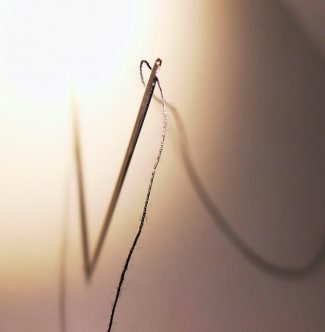Think Twice About Threads
 When will we stop writing about the thread lift? When doctors stop giving it new life with a new name and snappy marketing. There are just too many patients who end up disappointed with the results of this procedure, either having wasted money, suffered complications or both. For our patients in New York, a facelift, mid facelift or non-surgical treatment with perhaps a combination of skin rejuvenation plus Botox and/or fillers produces more satisfying results.
When will we stop writing about the thread lift? When doctors stop giving it new life with a new name and snappy marketing. There are just too many patients who end up disappointed with the results of this procedure, either having wasted money, suffered complications or both. For our patients in New York, a facelift, mid facelift or non-surgical treatment with perhaps a combination of skin rejuvenation plus Botox and/or fillers produces more satisfying results.
The Evolution of the Thread Lift
One of the earliest versions of the thread lift was called the Contour Thread Lift system, approved by the FDA in 2005. It employed permanent barbed sutures implanted under facial skin, then pulled upward to achieve the desired lift. A study outlined in the Journal of the American Medical Association (JAMA) in 2009 found:
The thread-lift provides only limited short-term improvement that may be largely attributed to postprocedural edema and inflammation. Our results objectively demonstrate the poor long-term sustainability of the thread-lift procedure. Given these findings, as well as the measurable risk of adverse events and patient discomfort, we cannot justify further use of this procedure for facial rejuvenation.
In other words, the Contour Thread Lift didn’t work. In fact, so many complaints about the procedure surfaced—including lumps, prolonged pain, infection, and threads showing through the skin—the Contour Thread Lift system was removed from the market.
But the idea of lifting facial skin with permanent, barbed threads did not go away. It resurfaced with new monikers including the Gold Thread Lift, the Featherlift, the Lunchtime Lift and more.
A New Generation of Threads
In recent years a new kind of thread has been manufactured to counter some of the complications of the first generation. Many of the newer threads are made up of PDO, or polydioxanone. The procedure using them is also called a “sugar lift” sometimes, since the threads are chains of a sugar compound, a Realself plastic surgeon explains. Another version, called the Silhouette Instalift, uses small cones made from a Sculptra-like (filler) substance—to anchor dissolvable threads. The idea is that the cones help build collagen while threads lift the skin.
The new threads are designed to dissolve gradually, which minimizes risks (especially of infection). And because they vanish over time, it’s not so common for patients to seek removal (which can be more complicated than it might seem, notes another Realself doctor).
Unfortunately, this vanishing act is exactly what makes the newer threads ineffective, says an article published this year in the Aesthetic Surgery Journal, the magazine of the American Society for Aesthetic Plastic Surgery, earlier this year. A comment in early in the article says it all: “…dissolvable threads do not last and as they dissolve, all benefits are lost…”
Why Thread Lifts Can Disappoint
Thread lift procedures often disappoint patients for reasons other than potential complications. One is, as discussed, initial benefits dissipate over time. Simply put, lifting just the facial skin cannot yield lasting results people seek. We explain to patients weighing their options that the full facelift procedure is still the gold standard for a reason: it elevates all the tissues of the face, including deeper structures, and removes excess skin. Read more about facelift details in this post.
Thread lift patients who do experience acceptable initial results find out they need additional rejuvenation help to keep aging at bay. Whether they choose an another thread lift, a full facelift or just repeated non-invasive treatments, the tab grows.
Doctors and Thread Lifts
The Contour Thread Lift, noted the JAMA article referenced above, required just a one-day training course from the manufacturer. This was a particularly bad start for this option, as non-board certified plastic surgeons such as dermatologists and M.D.s flocked to include it in their menu of services. Undertrained physicians added to the numbers of patients who suffered complications.
Doctors using the newer, dissolvable threads are still overwhelmingly not board certified plastic surgeons. They capitalize on the fact that they don’t need training in facial plastic surgery to perform these lucrative procedures, nor do they need an expensive anesthesiologist to assist. Patients are attracted by the lower initial cost and shorter down time.
Along with most other board certified plastic surgeons, we do not use threads for patients in New York. Facelifts, mid facelifts and tried and true non-invasive techniques, as we mentioned, are our tools. It’s not because we want to push people toward more surgery; we simply want what’s best for the men and women we serve.
Will Threads Ever Go Away?
We don’t know what the future of threads will be. No sooner did we spot a plastic surgeon predicting they might finally fade from the market next year than an “article” (paid advertising written by an “anti-aging specialist”) crossed our desk trumpeting the benefits of the Silhouette Instalift. And we frequently get email inviting us to classes on the latest thread procedure, such as one we just received. It covers “Korean Non-Surgical Face Lifting” and is presented by a dermatologist.
If you decide to work with us here in New York, a facelift may be our top recommendation. If your stage of aging does not require the full procedure, we may suggest treatment with one or more non-invasive options. But threads will not be one of them!
Email us to find out more about facial rejuvenation done right.